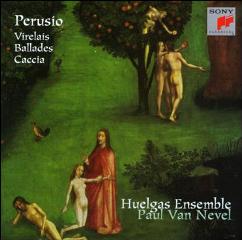Matteo da Perugia - Virelais, Ballades, Caccia (1996)
Matteo da Perugia - Virelais, Ballades, Caccia (1996)

1. Helas Avril (virelai à 3) 2. Ave, sancta mundi salus / Agnus Dei (isorythmic motet à 3) 3. Puisque la mort (ballade à 3) 4. Gloria - Spiritus et alme (troped, à 4) 5. Heylas que feray (virelai à 3) 6. Gloria (caccia à 3) 7. Già da rete d'amor (ballata à 3) 8. Trover ne puis (rondeau à 3) 9. Laurea martirii / Conlaudanda est (motet à 3 et 4) Huelgas Ensemble: Cécile Roovers, Marie-Claude Vallin, Ellen van Ham, Els Van Laethem, Katelijne Van Laethem, Eitan Sorek, Harry Van Berne, Stéphane Van Dijck, Willem Ceuleers, Harry van der Kamp (voices); Wim Bécu (trumpet), Bart Coen, Peter Declercq (recorder), An Van Laethem (fiddle), René Van Laken (fiddle, shawm). Paul Van Nevel – conductor
Little is known for certain about the life of the composer Matteo da Perugia. Until recent times, with the discovery of two fragments of manuscripts, his only surviving works were found in a single manuscript. Church records are the only other source of information about a composer whose works continue to interest scholars and performers of early music.
While his name leads to the assumption that Perugia was his birthplace, the town was in fact annexed by Milan in 1399, and there is more definite evidence to show that he was active rather in the latter city. From 1402 until 1407 he served as the first magister capellae (master of the chorus) and cantor at the Milan Cathedral, which was still being built at the time. His duties there are recorded as including the canting of two Masses on solemnities, the teaching of music at the cathedral school, and private musical tutoring.
This position was most likely owed to the influence of a powerful cleric who seems to have become Matteo's patron. The archbishop of Milan, Pietro Filargo di Candia, who would later be crowned antipope Alexander V, was educated in Paris and much influenced by French style. In Matteo he found a composer with similar tastes; Matteo's works show him to have been adept at the French fixed forms that had arisen in the fourteenth century, including the virelai, rondeau, and chanson. Indeed, most of Matteo's extant compositions have texts in French, some of which he may have composed himself, as the lyrical eccentricities correspond with some of his unconventional musical techniques.
In 1406, Matteo left Milan for Pavia, where Filargo, now a cardinal, was keeping his court, lecturing at the local university. He continued to draw salary from Milan until July 1407, when it became clear that he would remain in the service of the cardinal rather than the cathedral. Two years later Filargo was elected antipope in Pisa and moved to Bologna; Matteo may have accompanied him, but Filargo died in 1410 after less than a year as pontiff, and the composer did not serve his successor, John XXIII.
It was probably Filargo's influence that enabled the assembling of the manuscript (alpha.M.5.24 in Modena) that preserves 30 works, most of which have conclusively been attributed to Matteo. In addition to the French fixed forms, the manuscript contains other secular song forms, Italian ballatas and a canon, as well as sacred works, including isorhythmic motets and Mass movements. The presence also of several countertenor voices that Matteo composed to existing pieces by other contemporary composers shows that he was well aware of musical developments, although the limited survival of his own works suggests that his own influence was minimal.
By 1414 Matteo had again resumed his position at the Milan Cathedral, but two years later (October 1416) he again ceased to receive a salary. Intriguingly, the only reference to him after that comes from the year 1418, in which his successor complains that he was not paid as well as Matteo.
Matteo's idiosyncratic output includes some of the rhythmic innovation associated with the Ars Subtilior; but his unusual voice leading and melodic style stand out more in his works, often punctuated with surprising cadences. The suavity and craft of his recently discovered works have made him perhaps better-known today than he was to his contemporaries. --- Thomas Oram, All Music Guide
download: uploaded yandex anonfiles 4shared mediafire solidfiles mega filecloudio nornar
Zmieniony (Sobota, 15 Luty 2014 20:27)








